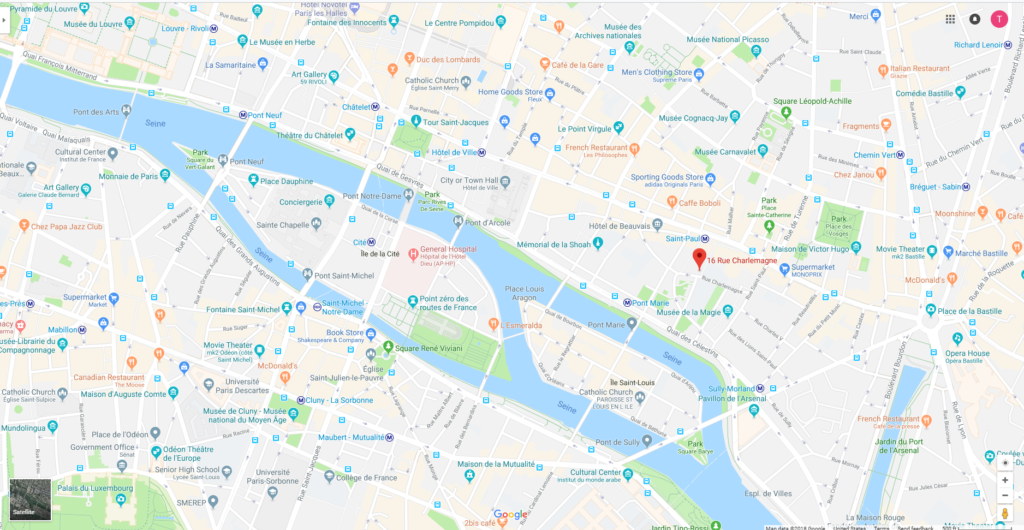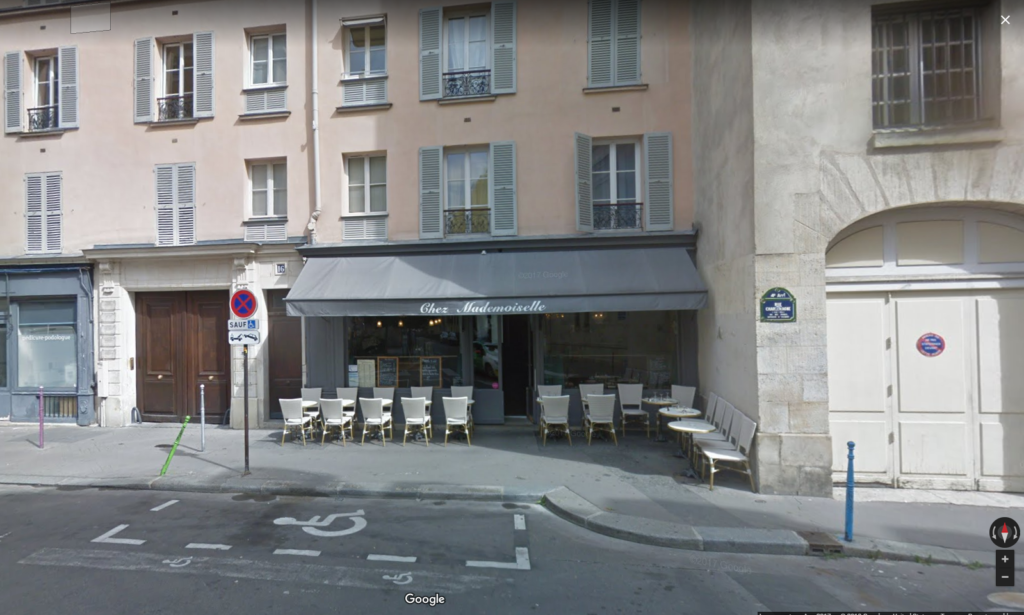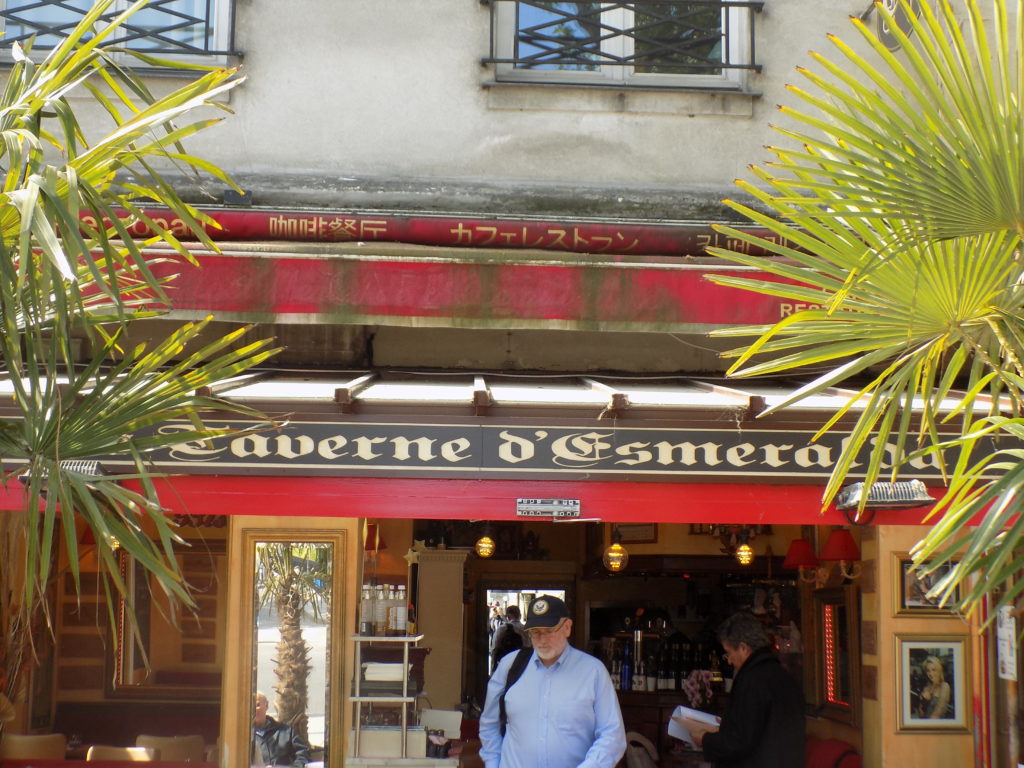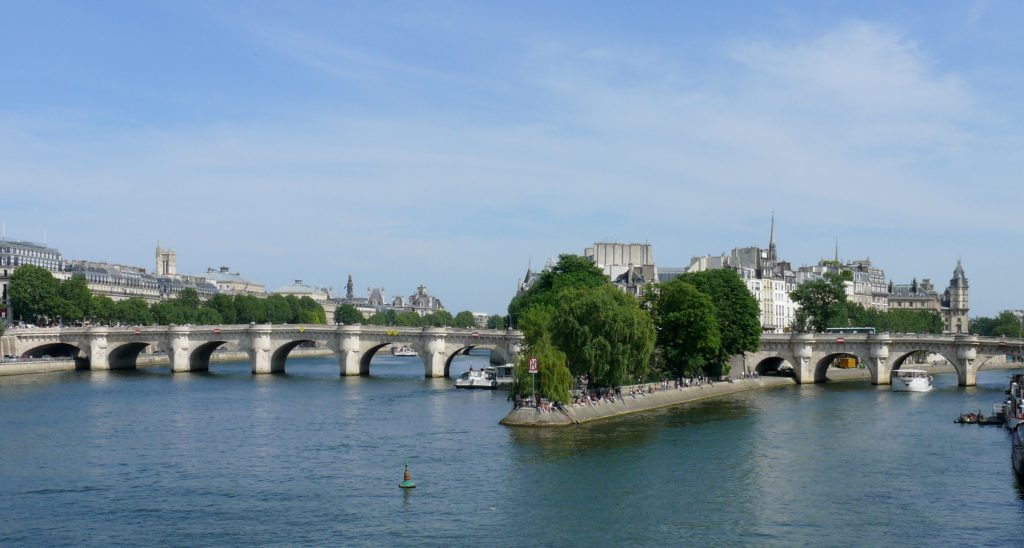After the concert in Giverny, we boarded our buses and returned to the ship for the final time. Sometime during the night we’d set sail for Paris and, in the morning, would go our separate ways. Some in the group were returning to the States while others, including Pat and me, had extended our stay in France either remaining in Paris – as Pat and I did – or visiting other regions as some of our fellow travelers had arranged. (The red dot on the map below marks the location of the flat we’d rented and, if you’ve traveled with me since the beginning of the trip, the area should look familiar.)
I think the original schedule had planned to have Jie and Tim premiere her composition after dinner Wednesday night but when the auditorium at the museum in Giverny became available the powers that be rescheduled the concert for that venue. This was not only an appropriate bookend to Jie’s introductory concert at the American Church but also provided a better listening space – one where we could be certain to be undisturbed by a rumbling, deck shaking resonating diesel exertion which would have been a likely shipboard accompaniment.
However, since we’d had a farewell performance by the crew Tuesday night, we faced an evening with no postprandial entertainment. On one hand, this was probably welcome news for those who had the early 06:00 transfer to the airport. It was, I think, a bit less welcome for those of us who had scheduled later, more leisurely departures.
Some of us lingered after dinner a bit longer than usual, exchanged contact information, (including, in our case, with Sharon and Jim who were also staying in Paris for a few days) and, as a treat for the extreme dawdlers, an encore performance from Captain Jerome, the mysterious saxophone player who would periodically appear from the kitchen to play Happy Birthday, and Andrey our Croatian (or was he Hungarian?) bartender.
Having settled our bills the previous night, Pat and I shared our final breakfast buffet. (I have to admit that while one could have constructed literally dozens of different breakfasts, I didn’t avail myself of that variety. Once I saw the endless tray of smoked salmon on the first morning and had it reappear each morning thereafter, that became the centerpiece of my morning meal. Occasionally, I’d vary the accompaniment – maybe different fruit or different bread, eggs or herring or sable when they were offered – but building my plate always began with the smoked salmon.)
The dining room crew was almost entirely eastern European and, having learned to greet them in their various native languages, I naturally took my leave with a string of thank yous and goodbyes in Bulgarian, Romanian, Slovenian, Croatian, Hungarian and, of course, German – Благодаря (Bla-Go-DAHR-ya) Довиждане (Do-VIZH-duh-neh), mulĹŁumesc (MOOL-Tsoo-mesk) la revedere (LAH Rev-eh-DEH-reh), hvala (h-VAH-La) zdravo (Z-DRAH-VO), hvala doviÄ‘enja (Do-vee-JEN-yuh), Kösönöm (KEU-seu-num) Viszlát (VEES-Laht), and, of course, Danke Auf Wiedersehen.
The staff had booked us a cab for 09:30 and we arrived at the flat we’d let in le Marais at about 10:00.
[Screen capture from Google maps.]
We entered the building through the double doors on the left and then through another private entrance to the flat. The outer doors were open for workmen’s use and someone exited the inner entry as we arrived so we had no need to call our hostess. The flat was on the fifth floor (or, in European usage the fourth floor – ground floor 0, second floor 1, etc.) but one of the reasons we chose this building was for its (as it turned out intimately tiny) ascenseur.
We met our hostess, Celeste, (not her real name) as she was busy repairing some damage a previous guest had inflicted upon the flat. She provided a quick orientation, asked us to leave our bags, and to occupy ourselves for a few hours while she finished her work. We happily complied thinking we could have a bit of a walk, eat some lunch, and get a general orientation to the neighborhood – and what a neighborhood it was!
If you enlarge the map above, you’ll see a number of the places we’d visited during our first stay in Paris. Walk south for just more than a kilometer and we were on the ĂŽle de la CitĂ© at Notre-Dame; 600 meters north was the Place des Vosges (which we’ll learn about in depth when we visit there with David on Friday); 850 meters to the east is the Place de la Bastille (where nothing but a few stones remain outlining the perimeter of the infamous fortress prison but which is the home of the new Opera House); and, walk about two-an-a-half kilometers west and we could be at the famous Pyramide du Louvre. And all of this came before we learned about the shops, cafĂ©s, and clubs in the immediate neighborhood and the MĂ©tro almost right outside our door on the building’s opposite side.
We set out toward the river and crossed the Pont Marie onto the Île Saint-Louis. After a brief look around the small island, we continued across the Pont de la Tournelle onto the Quai de la Tournelle on la Rive Gauche. (For those of you who are fans of the television’s Highlander: The Series, both the underside of the bridge and the Quai were used as shooting locations.)
We turned west in the direction of ĂŽle de la CitĂ© and decided to stop for a bite at what is now called Le CafĂ© Siam. However, given that it’s in sight of Notre-Dame, it’s also appropriate that, as seen on the sign, it once had a different name.
As we were enjoying our plate of bread and cheese – mine with tea while Patricia continued chasing the elusive perfect cup of coffee – I looked at what appeared to be a line of shuttered catafalques across the street.
You can spot these padlocked green boxes lining quais on either side of the Seine and, of course, they’re not in any sense funerary nor are they the preserved relics of ancient Parisian Public Storage units. They are, in fact, places of business – bouquinistes or bookstalls.
Once again, I recalled David Downie’s book Paris, Paris in which he devotes a chapter to these most Parisian enterprises (written, I will add, with greater eloquence than I and with a strong personal connection as well). As we nibbled on the cheese and I tore into the bread (how I adore those fresh baguettes!), I tried to recall some of their history (knowing that I’d look up the details on my return).
Johannes Gutenberg invented the printing press sometime around 1440 and Paris’ first press was installed at the Sorbonne in 1470. The city’s first bookstores were established in the beginning of the 16th century and within a few decades itinerant booksellers began peddling their wares by walking the streets of the Cité and the bridges connecting the island to Paris on both sides of the Seine.
The first regulations came in 1606 with laws limiting the sales to daylight hours and the area in the vicinity of the (confoundingly named) Pont Neuf – about a kilometer west of our light lunch spot.
(Not only does the name Pont Neuf have nothing to do with the number nine, its name translates as New Bridge although it is the oldest standing bridge spanning the Seine in Paris. Construction of the bridge began in 1578 when King Henri III laid the first stone. Several design changes proposed during its early construction delayed its completion.Â
Work on the bridge ceased completely for more than a decade beginning in 1588 when the increasing intensity of the Wars of Religion diverted the attention of the monarchy. Construction resumed in 1599 under the reign of Henri IV – the first of the Bourbon kings. Though it opened to traffic in 1604, the bridge wasn’t fully completed until 1606. It was dedicated by Henri IV in 1607.
It was, in fact, Henri who bestowed the name New Bridge on the structure. While it had been constructed using fairly traditional methods, some of its features were quite modern for its time. It was, at the king’s insistence, the first Parisian stone bridge not to support houses. For a time, it was also the widest bridge in the city, and it was the first bridge to have a pavement that protected pedestrians from mud and horses.)
Coming up, a longer look at the bouquinistes and much, much more.
Note: In keeping with my 2022-2023 reformation of the blog into shorter entries, backdated to maintain their sequence, any comments on this post might pertain to its new configuration. See the full explanation in the post Conventions and Conversions.






1. I can’t believe I missed the street of the cat who fishes (aka Fishing Cat Street, but somehow it sounds funnier the other way.) I don’t even remember it, and you know how I also love streets with funky names. Is it possible I was asleep on my feet at that time?
2. I can’t believe you also own the Best of Nana Mouskouri album. Bought my copy in 1970. Finally gave it away because I ditched my turntable and I can download mp3 versions. Le Temp des Cerises may be her best number on it.
3. CanellĂ©s a la profiterole or just profiteroles, yours looked outrageous and I’m sure it tasted swell too. Should have taken a photo of THAT.
Well, truth be told, I missed Fishing Cat Street, too. It was the hotel sign that I shot in the picture. It was when I was looking for info on the church and when I read about it wondered if it was the the street by the hotel sign which you can see in the photo album (I cropped that sign out of the image in the post so readers could see it’s really a “street”) and that turned out to be the case.
Like you, I no longer have the Nana Mouskouri album. It was a “casualty” of downsizing my DC collection by 90% or so from 2,500+ to about 250-300.
You’re right. I should have taken a picture of the dessert but since the Budapest camera incident, I rarely take my camera at night and the notion of using my phone is equally rare.
Dobrze napisane